Papayas, also called pawpaws, are tasty tropical fruits rich in vitamin C. Their medicinal properties make them highly valuable. Additionally, it is a fast-growing plant with a long fruiting period and high nutritional value. Containers, greenhouses, polyhouses, and pots can all be used to grow them. Furthermore, it has health benefits, such as relieving constipation, lowering cholesterol, and fighting cancer cells. Furthermore, vitamins A and C are abundant in them.
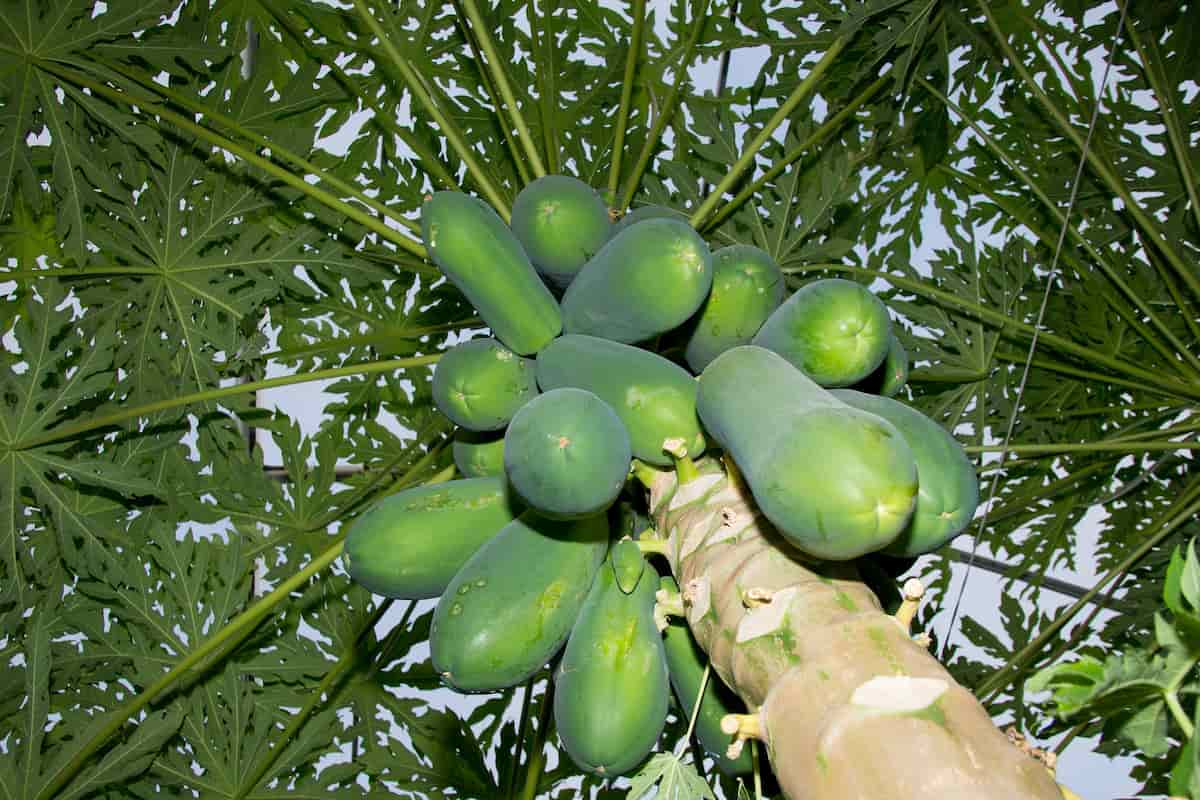
The plant was originally cultivated in Costa Rica and South Mexico but is now widely cultivated worldwide. Papaya production in the world is led by India, followed by Brazil, Mexico, Nigeria, Indonesia, Peru, China, Thailand, and the Philippines. A highly productive crop, papaya is widely cultivated in India because it grows easily and is highly productive.
Honey Dew Papaya farming in India
Honey Dew Papaya
- Known as Madhubindu, this plant is cultivated for table and processing purposes. The plant is semi-dwarf and gynodioecious.
- By growing in isolation, the variety can be maintained purely. Market value is high due to its excellent fruit quality.
- Papaya plants grow straight up to 16 to 33 feet tall. Branching occurs only when there is damage at the apex of the stem; otherwise, they are unbranched.
- The leaves have a long stalks and are shaped like a fan. There are five petals on the dimorphic flowers.
- Male flowers have fused stamens with petals, while female flowers have contorted petals with superior ovaries.
- There is a loose attachment between the petals of the flower at the base of the flower. Pollination is usually done at night by moths.
- On average, fruits weigh about 1.5 to 2.0 kg, and their skin is dark with ridging.
- Hermaphrodite trees produce elongated and oval fruits. It is oval for females.
- On ripening, the pulp is yellow and melts; TSS is around 13.5° Brix. Keeping quality is poor.
- The tree yields about 70 kg per year. The cultivation of Coorg Honey Dew papaya has resulted in a 25-30% increase in fruit and papain production
- In India, Maharashtra, Karnataka, West Bengal, Orissa, Jammu and Kashmir, Bihar, Gujarat, Himachal Pradesh, U.K., Tamil Nadu, and Andhra Pradesh are some of the major papaya farming states.
Climate for Honey Dew Papaya cultivation
As tropical crops, papaya crops require high humidity and temperature. It is sensitive to frost, and heavy rains can damage it. Subtropical areas can also grow it. Papayas are best grown in the foothills of the Himalayas in India. It can grow well at sea level and altitudes up to 600 meters.
When the fruits are above 600m, their quality decreases. Despite the crop’s preference for high humidity levels for growth, it needs a warm and dry climate for ripening. Papaya plants can’t withstand strong winds because their roots are shallow. It is also possible to cultivate papaya in greenhouses.
In case you missed it: Red Lady Taiwan Papaya Farming in India: How to Start, Yield, Care, and Management
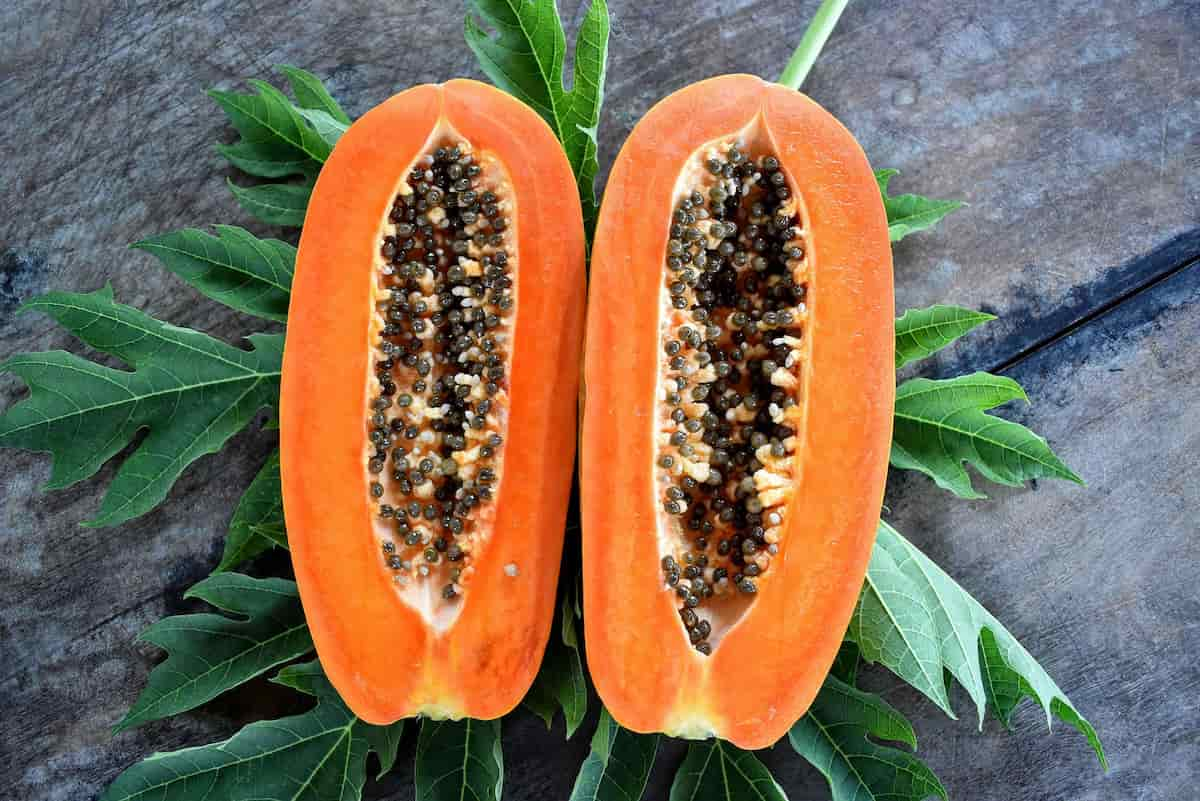
Soil for Honey Dew Papaya plantation
Various soils can be used to grow papaya. Papaya plantations, however, prefer rich, sandy loams. Deltas and river banks can also support its growth in alluvial soil. The plant, however, cannot grow in shallow soils or soils that do not allow water to drain easily. It is therefore recommended to cultivate papaya in fertile, lime-free, and well-drained soil. Papayas can be grown in neutral or near-neutral soil. pH levels can range from 5.5 to 7.5.
The season for honeydew Papaya plantation
The papaya plant is planted during the monsoon, autumn, and spring seasons. However, the crop is not planted during winter since frost can damage it. In other words, they are planted from June to July (monsoon), October to November (autumn), or February to March (summer). It is important to consider rain, frost, and hot air when planting papaya because all three can cause damage to the plant.
Planting material for Honey Dew Papaya farming
Seeds are used in the commercial propagation of papayas. Although tissue culture techniques have been developed for growing papaya, they are restricted to laboratories. Since papaya seeds lose their viability quickly, they cannot be stored for long. As a result, they are planted first in poly bags in nurseries. After 6-8 weeks, the newly-germinated young seedlings are transplanted.
Honey Dew Papaya seedling raising
Raised beds and polythene bags are the two types of nursery raising used by farmers. Captan should be applied to the seeds before sowing at a rate of 3 grams per kilogram. Seeds are sown from the second week of July to the third week of September. For each acre of land, use 150 to 200 grams of seeds.
- In raised beds, fine soil is prepared, and manure and seeds are sown at the correct spacing in the required quantity. Alternatively, papaya seeds can be sown in polythene bags with good rooting media and raised in a greenhouse
- Polythene bags filled with nutritive rooting medium can also raise papaya seeds. Seedlings are prepared in polythene bags measuring 25 X 10 cm. The lower part of this polythene has 8-10 holes with a diameter of 1mm to allow water to drain properly. FYM, soil, and sand are mixed equally in polythene bags. Most seeds are sown in polythene bags from the second week of July to the third week of September.
In case you missed it: How to Grow Papaya from Seeds at Home: In Containers, Indoors, Backyard, and On the Terrace
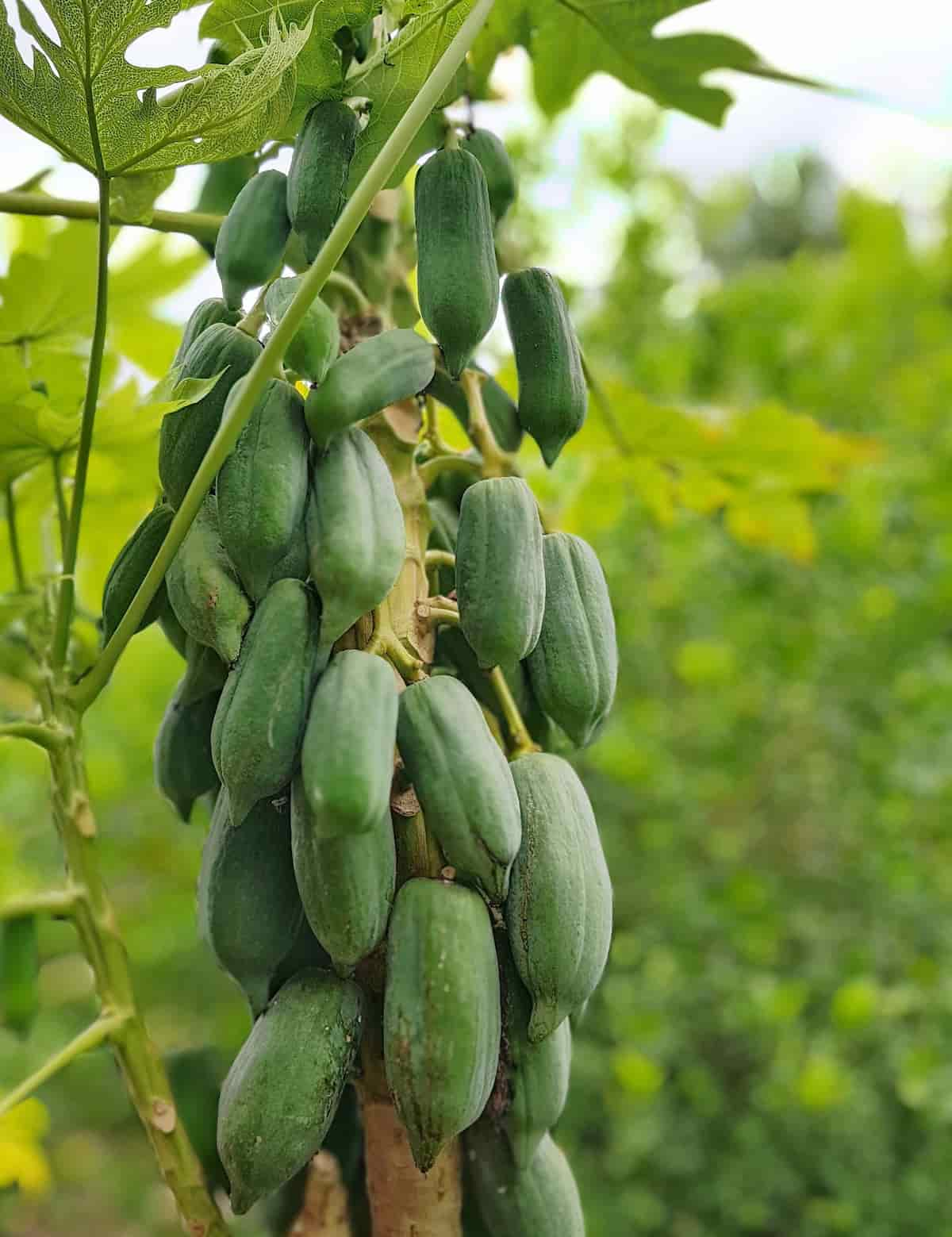
During seedling emergence, seedlings are drenched with Captain at 0.2% to prevent damping off disease. Seeds need to be raised in a protective structure that protects them from adverse environmental conditions, pests, and diseases. The same protection measures need to be taken against damping off. After 45 days, the saplings can be transplanted into the main field. In September-October, seedlings are transplanted.
Land preparation and planting methods for Papaya plantation
During rainy seasons, papaya cultivation land must be protected from strong winds and not easily flooded. The land must be protected from strong winds by windbreaks. After six to eight weeks of growth, seedlings are transplanted to the main field from nurseries. A month before transplantation, pits measuring 50 cm X 50 cm X 50 cm are dug.
Besides topsoil, the pits are filled with 20 kg of farmyard manure, 1 kg neem cake, and 1 kg bone meal. In general, tall and vigorous varieties are planted at a wider spacing, while medium and dwarf varieties are planted at a closer spacing. In each pit, 2-3 seedlings are transplanted. Only one plant should be kept per pit when the plants start flowering. During the first year, weeds are controlled by regular hoeing. Only 10% of male plants are scattered in the orchard once the plants begin flowering.
Plant-plant and Row -Row spacing in Honey Dew Papaya planting
Generally, papaya plants planted at a distance of seven feet between trees and eight to nine feet between rows yield better results than those planted closer together. Nevertheless, farmers can maximize their returns by cultivating at 5 feet x 5 feet m spacings. It is because the papaya tree can reach heights of 30 feet in high-nutritional soils, but it grows best between 12 and 12 feet tall in low-nutritional soils. Shorter plants or trees will therefore be easier to harvest.
In case you missed it: Top 20 Steps to Boost Papaya Yield: How to Increase Fruit Size, and Production
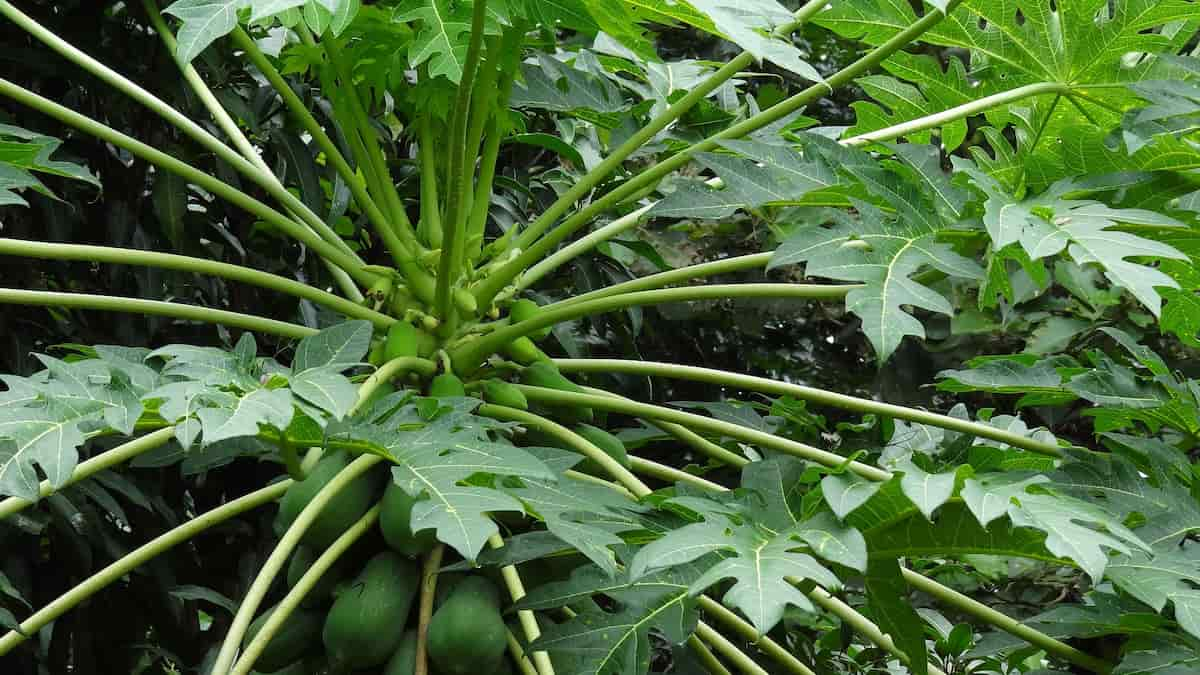
Honey Dew Papaya crop care
Watering Papaya Plant
Light, temperature, rainfall, wind, soil type, and other environmental factors determine papaya’s water requirement. In addition, it varies based on the plant’s age. Young papaya plants, for instance, require more moisture than older ones. There is a reason for this: older trees grow slower. Fruit-bearing trees require irrigation once every 15 days, whereas seedlings need irrigation once or twice a week.
Water is essential for older trees. However, due to their shallow roots, they cannot tolerate stagnant water or waterlog. As a result, ‘wet feet’ results and fruit yields are lower. It is for this reason that drip irrigation is recommended in papaya plantations. During the winter, papaya must be irrigated every 10-12 days; during the summer, they are watered once a week until the rains arrive.
Fertilizer application in Honey Dew Papaya cultivation
Fertilizers must be applied frequently to maintain a continuous supply of fruits. For fruiting to occur correctly, it is important to balance carbon and Nitrogen (C/N). Therefore, for maximum fruit yield, it is recommended that the plants receive the second dose of fertilizers.
Boosting crop growth and disease resistance can be achieved by applying 25-30 kg of well-decomposed farm yard manure fortified with the biofertilizer mix. In addition, manures enriched with Bifertilisers, vermicompost, Neem cake, and other ingredients beneficial to plants may be added. Every year, 1 – 2 kg should be applied per plant.
- Inorganic fertilizers may be applied as top dressings with Nitrogen – 200 – 250 g, Phosphorus – 200 – 250 g, and Potassium – 450 – 500 g per plant per year.
- Apply micronutrient mixtures including 120 grams, Ecohume granules (Plant biostimulants) 200 grams, Calcium nitrate 250 grams, Manganese sulfate 200 grams, and Magnesium sulfate 200 grams.
NPK can be administered in divided doses every 60 days. However, nutrients are lost due to volatilization and leaching when the application is given in divided doses. It is possible to supplement other nutrients three times per year in equal amounts. It is important to apply 15 to 20 grams of borax soil per plant per month to maintain flower health and fruit production.
Farmers should avoid applying excess Nitrogen because it increases vegetative growth and results in poor fruiting. In addition, due to ammoniacal nitrogen application to papaya plants, fruit setting decreases, and the chances of viral infections like Papaya ring spot virus and other viral infections increase.
Frost protection in Honey Dew Papaya farming
In North India, papaya cultivation must be protected from frost since papaya is sensitive to frost. From December to February, there is a chance of frost. Therefore, it is generally recommended to plant before the onset of winter. Also, polythene bags of plant size are used to cover the thatching around the plants. Air holes must be punched into the upper side of the bags. It is for the first winter. The following year, gunny bags can wrap the plant around the fruit and at the apex.
In case you missed it: Papaya Pests and Diseases, Control Management
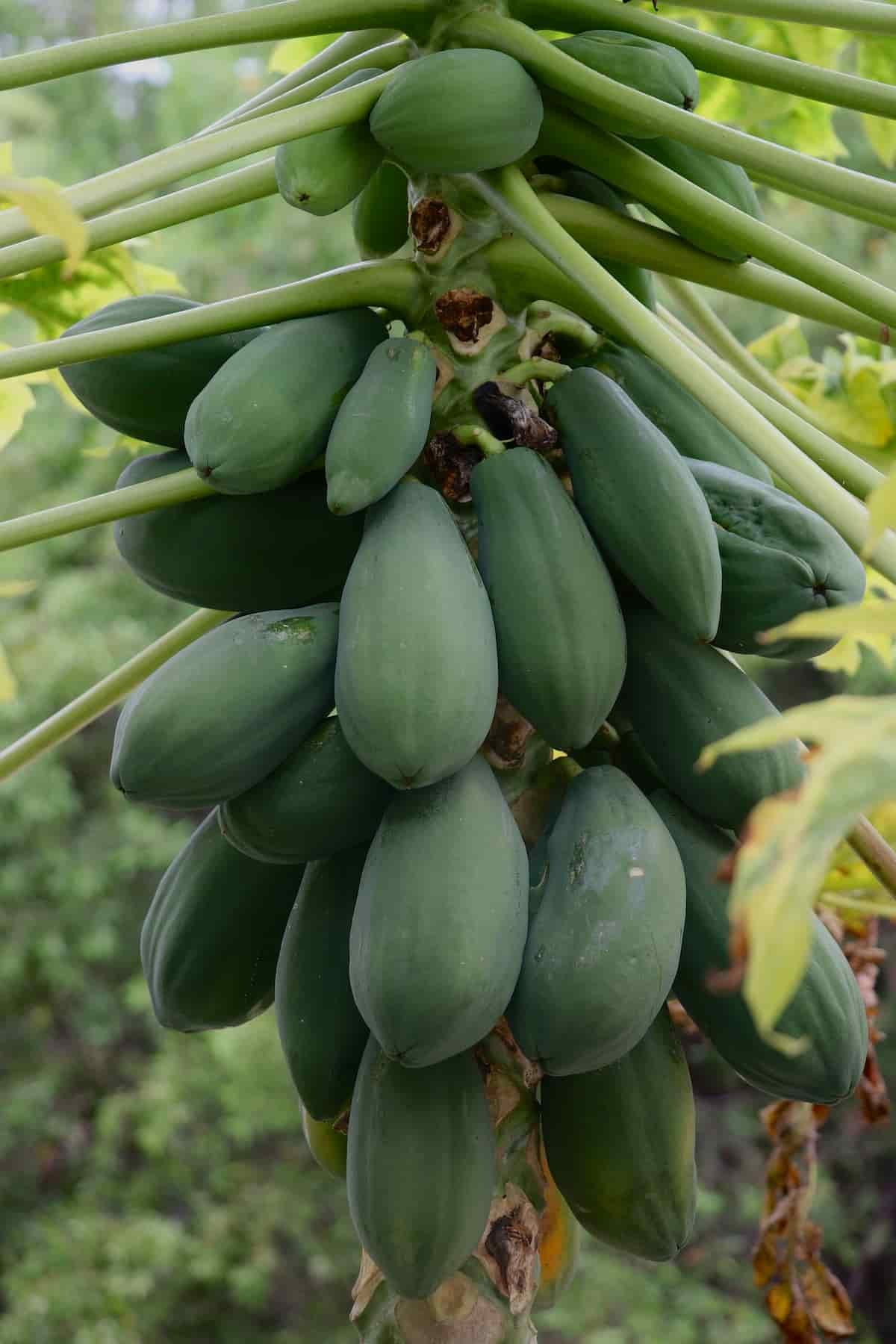
Weed management in Honey Dew Papaya
Weeds grow luxuriantly in papaya orchards and consume most of the nutrients. In addition, they compete for light, air, and water, resulting in poor fruiting. It is, therefore, crucial to keep papaya orchard weeds under control. A chemical spray or manual control should be used to control these weeds. No selective herbicides are approved for the papaya crop, and non-selective herbicides may be sprayed if they do not come into contact with papaya plants.
- In papaya plantations, use 30 ml of paraquat per 10 liters of water to control broad-leaved weeds.
- Against grass and broad-leaved weeds in papaya, use 25 to 30 ml of glyphosate per 10 liters of water.
- Young seedlings should not be sprayed with a spray solution that drifts.
- While conserving soil moisture, mulch effectively suppresses weed growth.
- Utilize grasses like Guatemala, Napier, and other plant materials to mulch the field whenever possible.
Honey Dew Papaya diseases
Foot rot of papaya
- Symptoms: Patches of the water-soaked stem near the ground level characterize it. They grow rapidly and wrap around the stem, rotting the tissues and turning dark brown or black. Plants affected by such diseases cannot withstand strong winds and topple over. In mild cases, only one side of the stem rots, leaving the plants stunted. The fruit is faded and malformed if it has formed. Eventually, the plant dies.
- Control methods: Plant papaya only on land that is well-drained. Waterlogged soil favors water molds. Also, plant on mounds or raised beds to prevent the accumulation of surface water. Use chlorothalonil, copper, or mancozeb (protectants), or alternate with metalaxyl or phosphorous acid.
Leaf Curl of Papaya
- Symptoms: This disease is transmitted by the white vector fly (Bemisia tabaci). Due to this disease, there is severe curling, crinkling, and deformation of the leaves. Young leaves are most affected. In addition to curling, the leaves also show vein clearing and thickening. Petioles can sometimes be twisted. In severe cases, the affected plant is completely defoliated. Moreover, the affected plants show stunted growth and reduced fruit production.
- Control methods: Remove and destroy the affected plants. Carbofuran is applied to the soil when sowing (1 kg a.i./ha). 4-5 sprays of Dimethoate (0.05%), Metasystox (0.02%), or Nuvacron (0.05%) at 10-day intervals effectively control whiteflies.
Papaya ring spot disease
- Symptoms: The infected plant initially shows cholorsis on the youngest leaves, followed by vein clearing, rugosity, and prominent mottling of laminae. Elongated dark green streaks are visible along the petiole and stem upper half. There is a yield loss of up to 56-60% in fruits with infected concentric rings.
- Control methods: When sowing seeds, use carbofuran (1 kg a.i./ha) in the nursery bed, followed by 2-3 foliar sprays of phosphomidon (0.05%) every ten days from 15-20 days after sowing.
Pests of Honey Dew Papaya
Whitefly
- Symptoms: Plants are reduced in vigor by both adults and nymphs sucking plant sap. Severe infestations result in yellow leaves that fall off. A large amount of honeydew is secreted on leaf surfaces, causing sooty mold to grow, which reduces the plant’s ability to photosynthesize.
- Control methods: Field sanitation Removal of host plants Installation of yellow sticky traps During a heavy infestation, spray application of imidacloprid 200SL at 0.01% or triazophos 40EC at 0.06%. Spray neem oil 3% or NSKE 5%
Aphids
- Symptoms: Under the surface of leaves and tender shoots are infested. Stunted growth due to curling and crinkling of leaves Honeydew excretion causes black sooty mold to develop
- Control methods: Remove and destroy damaged plant parts Spray dimethoate 0.03% or methyl demeton 0.025%
Fruit fly
- Symptoms: Females puncture mature fruits’ outer walls and insert eggs inside the mesocarp using their pointed ovipositors. On hatching, the larvae feed on fruit pulp, and the infested fruits start rotting due to further secondary infection.
- Control methods: Heavy application of dust and sprays of pyrethrum or BHC Spray fenthion 100 EC 2 ml/ lit or malathion 50 EC 2 ml/lit.
Papaya Mealybugs
- Symptoms: Initially, the affected area will be chloritic, then turn brown and dry out. The infested portion becomes shiny and moist from honeydew excreted by these bugs. Finally, the affected parts become black due to a secondary infection with a sooty fungus, Capnodium. Clusters of cotton-like masses can be observed on the ground parts of leaves, stems, and fruits
- Control methods: Apply any one of the following insecticides:
- Thiomethaxom at 0.5 gm per liter
- Dimethoate at 2 gm per liter
- Flupyradifurone at 2 ml per liter
- Spirotetramat 11.01% + Imidacloprid 11.01% w/w SC (240 SC) at 0.5 – 1 ml per liter
Harvesting Honey Dew Papaya
It is time to harvest the fruits when they turn yellow at the apex and are fully grown. Latex is another indicator of harvesting time. The fruits must be harvested once the latex turns watery instead of milky. The color of papayas ripens differently depending on the variety.
The color of some fruits varies from yellow to green, depending on how ripe they are. Papaya has a maximum economic life of four years. Farmers, however, do not extend their lives beyond 2-3 years because production decreases after the third year. However, good farm management and timely care can greatly increase papaya production.
In case you missed it: A Step-By-Step Guide to High Density Fruit Farming: For Guava, Banana, Mango, Pineapple, Lemon, Papaya, Litchi, and Apple
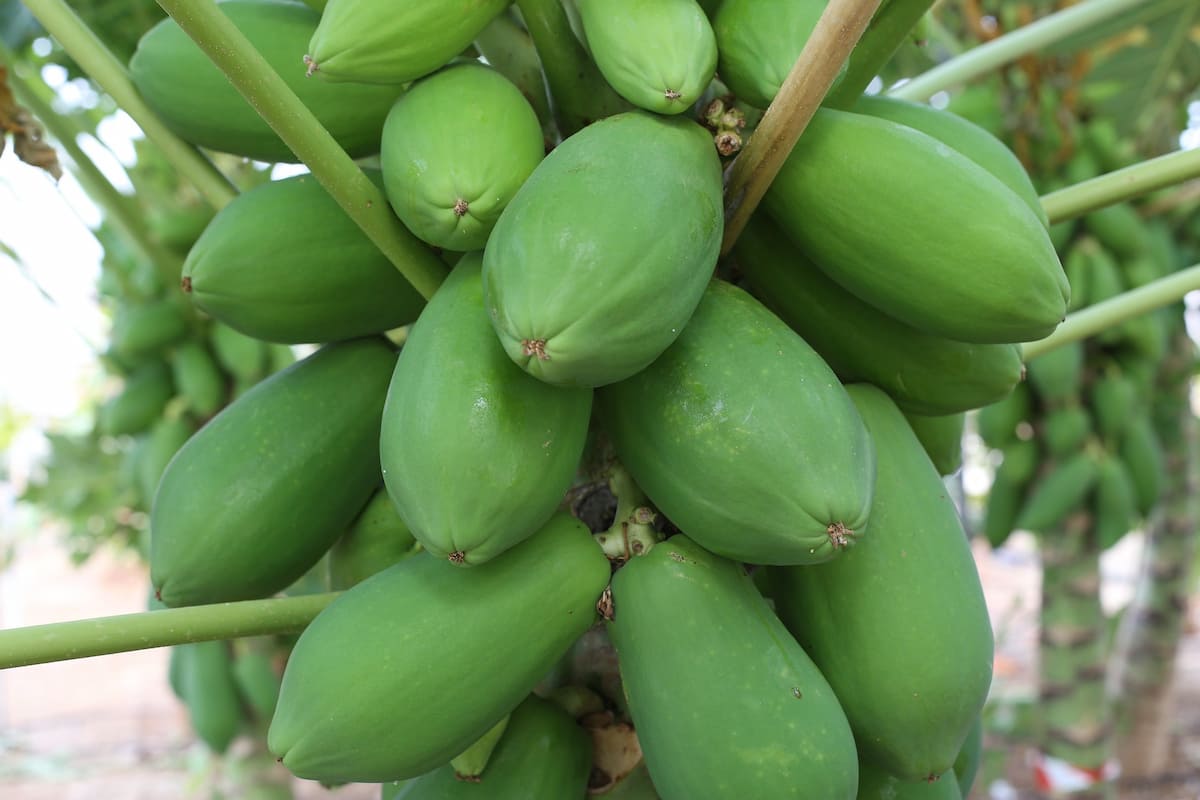
Post-Harvesting practices followed in Honey Dew Papaya
Papayas must not have any injuries or blemishes at harvest time. Fungal contamination can occur from these sources. The fruits would decay rapidly in that case, reducing their market value. As perishable fruits, papayas must also be wrapped separately in paper and placed in wooden crates. Straw, sawdust, and other soft materials must fill the crates to protect the papayas during transportation.
Conclusion
As far as cultivating Honey Dew Papayas is concerned, it does not require too much hard work on your part. This crop has several uses, and it can be cultivated as a vegetable, fruit, and latex crop. In addition, even dry leaves have a market value as a raw material for medical use.
- Types of Pesticides Used in Agriculture: A Beginner’s Guide
- Economical Aquaculture: A Guide to Low-Budget Fish Farming
- 15 Common Planting Errors That Can Doom Your Fruit Trees
- How to Make Houseplants Bushy: Effective Tips and Ideas
- Innovative Strategies for Boosting Coconut Pollination and Yield
- Pollination Strategies for Maximum Pumpkin Yield
- The Complete Guide to Chicken Fattening: Strategies for Maximum Growth
- Natural Solutions for Tulip Problems: 100% Effective Remedies for Leaf and Bulb-Related Issues
- Revolutionizing Citrus Preservation: Towards a Healthier, Greener Future
- Natural Solutions for Peony Leaf and Flower Problems: 100% Effective Remedies
- Maximizing Profits with Avocado Contract Farming in India: A Comprehensive Guide
- Natural Solutions for Hydrangea Problems: 100% Effective Remedies for Leaf and Flowers
- The Ultimate Guide to Choosing the Perfect Foliage Friend: Bringing Life Indoors
- From Sunlight to Sustainability: 15 Ways to Use Solar Technology in Agriculture
- The Ultimate Guide to Dong Tao Chicken: Exploring from History to Raising
- The Eco-Friendly Makeover: How to Convert Your Unused Swimming Pool into a Fish Pond
- Mastering the Art of Delaware Chicken Farming: Essentials for Healthy Backyard Flocks
- 20 Best Homemade Fertilizers for Money Plant: DIY Recipes and Application Methods
- How to Craft a Comprehensive Free-Range Chicken Farming Business Plan
- Brighten Your Flock: Raising Easter Egger Chickens for Beauty and Bounty
- How to Optimize Your Poultry Egg Farm Business Plan with These Strategies
- Subsidy for Spirulina Cultivation: How Indian Government Schemes Encouraging Spirulina Farmers
- Ultimate Guide to Raising Dominique Chickens: Breeding, Feeding, Egg-Production, and Care
- Mastering the Art of Raising Jersey Giant Chickens: Care, Feeding, and More
- Ultimate Guide to Raising Legbar Chickens: Breeding, Farming Practices, Diet, Egg-Production
- How to Raise Welsummer Chickens: A Comprehensive Guide for Beginners
- How to Protect Indoor Plants in Winter: A Comprehensive Guide
- Ultimate Guide to Grow Bag Gardening: Tips, Tricks, and Planting Ideas for Urban Gardeners
- Guide to Lotus Cultivation: How to Propagate, Plant, Grow, Care, Cost, and Profit
- Agriculture Drone Subsidy Scheme: Government Kisan Subsidy, License, and How to Apply Online
- Ultimate Guide to Raising Araucana Chickens: Breed Profile, Farming Economics, Diet, and Care
- Bringing Hydroponics to Classroom: Importance, Benefits of Learning for School Students
- Ultimate Guide to Raising Polish Chickens: Breed Profile, Farming Economics, Diet, and Care
- Ultimate Guide to Raising Australorp Chickens: Profile, Farming Economics, Egg Production, Diet, and Care
- Silkie Chicken Farming: Raising Practices, Varieties, Egg Production, Diet, and Care
- Sussex Chicken Farming: Raising Practices, Varieties, Egg Production, Diet and Care